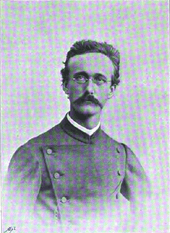Karl Sapper
Karl Theodor Sapper (6 February 1866 – 29 March 1945) was a German traveller, explorer, antiquarian and linguist, who is known for his research into the natural history, cultures and languages of Central America around the turn of the 20th century.

Sapper spent over twelve years (1888–95)[1] traveling through much of Central America, and in the process published a number of scientific works on aspects from vulcanology to Mesoamerican languages to descriptions and maps of Maya archaeological sites.[2]
Sapper's contributions to the study of Mesoamerican languages include his initial proposal, made in a 1912 paper, which surmised that the highland regions of Chiapas and Guatemala was the location from which the Mayan languages and the Maya peoples later diversified.[3] The assessment of a number of modern linguists places the likely home of the Proto-Mayan language as being centered on the Cuchumatanes highlands of Guatemala, with a subsequent early occupancy of the Chiapas highlands proper.[4]
Sapper is commemorated in the scientific names of two Central American snakes: Amastridium sapperi and Micrurus diastema sapperi.[5]
Footnotes
- As cited in Dienhart (1997), "Data sources listed by author" Archived 2016-08-21 at the Wayback Machine.
- Hirst, (n.d.)
- Fernández de Miranda (1968), p.75.
- See for example Campbell (1997), p.165.
- Beolens, Bo; Watkins, Michael; Grayson, Michael (2011). The Eponym Dictionary of Reptiles. Baltimore: Johns Hopkins University Press. xiii + 296 pp. ISBN 978-1-4214-0135-5. ("Sapper", p. 232).
References
- Campbell, Lyle (1997). American Indian Languages: The Historical Linguistics of Native America. Oxford Studies in Anthropological Linguistics, no. 4. New York: Oxford University Press. ISBN 0-19-509427-1.
- Dienhart, John M. (1997). "The Mayan Languages- A Comparative Vocabulary". Odense University. Archived from the original (electronic version) on 2006-12-08. Retrieved 2006-12-20.
- Fernández de Miranda, María Teresa (1968). "Inventory of Classificatory Materials". In Norman A. McQuown (Volume ed.) (ed.). Handbook of Middle American Indians, Vol. 5: Linguistics. R. Wauchope (General Editor). Austin: University of Texas Press. pp. 63–78. ISBN 0-292-73665-7. OCLC 277126.
- Schumacher, Gudrun; Gregor Wolff (November 2004). Nachlässe, Manuskripte, und Autographen im Besitz des IAI (PDF online document). Abteilung 2, Referat 1: Nachlässe und Sondersammlungen (in German). Berlin: Ibero-Amerikanisches Institut, Preußischer Kulturbesitz. OCLC 162302418. Retrieved 2008-04-10.
- Hirst, K. Kris (n.d.). "Karl Sapper [1886-1945]". Dictionary of Archaeology. About Archaeology. Archived from the original on 2005-10-19. Retrieved 2006-12-18.
- Sapper, Karl (1897). Das nördliche Mittel-Amerika nebst einem Ausflug nach dem Hochland von Anahuac (in German). Braunschweig, Germany: Friedrich Vieweg und Sohn. OCLC 70337620.